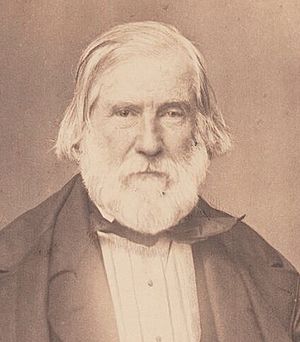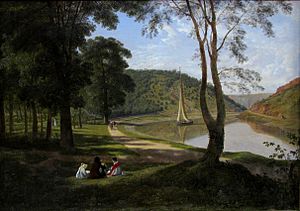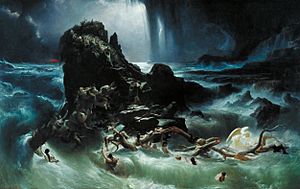Francis Danby facts for kids
Quick facts for kids
Francis Danby
|
|
|---|---|

Danby in the 1850s
|
|
| Born | 16 November 1793 County Wexford, Ireland
|
| Died | 9 February 1861 (aged 67) Exmouth, England
|
| Nationality | Irish |
| Known for | Landscape painting |
Francis Danby (16 November 1793 – 9 February 1861) was an Irish painter. He was known for his exciting and imaginative landscape paintings. His art style was part of the Romantic era.
Danby's dramatic landscapes were often compared to those of another famous painter, John Martin. Danby first developed his unique style while working with a group of artists called the Bristol School. He became most successful in London during the 1820s.
Contents
Early Life and Art Beginnings
Francis Danby was born in the south-east of Ireland in 1793. He was one of a pair of twins. His father, James Danby, owned a small farm near Wexford. When his father died in 1807, Francis was still a schoolboy. His family then moved to Dublin.
In Dublin, Francis started learning to draw at the Royal Dublin Society's schools. He also began painting landscapes with a young artist named James Arthur O'Connor. Danby also met another artist, George Petrie, around this time.

In 1813, Danby traveled to London with O'Connor and Petrie. They did not have much money for this trip. Because of this, they soon had to walk all the way back home. They stopped in Bristol. Danby found he could earn money by selling his watercolor paintings there. He decided to stay in Bristol and worked very hard. He sent important oil paintings to exhibitions in London, and these large works quickly gained attention.
The Bristol School of Artists
Around 1818 or 1819, Danby joined an informal group of artists. This group became known as the Bristol School. They would meet in the evenings to sketch and go on trips to draw local scenery. Danby's painting View of the Avon Gorge (1822) shows artists sketching in a spot the group liked. He stayed connected with the Bristol School artists for about ten years, even after he left Bristol in 1824.
The Bristol School first formed around an artist named Edward Bird. Danby later became the main figure of the group after Bird. Bird's paintings of everyday life had a natural style and bright colors. This style influenced Danby's work. You can see this in how Danby painted people in Boys Sailing a Little Boat (around 1821) and The Delivery of Israel out of Egypt (1825). Danby was also close to Edward Villiers Rippingille, whose art style grew alongside Danby's.
Some amateur artists in Bristol, especially Francis Gold, also helped Danby develop his imaginative and poetic style. George Cumberland, another amateur artist, had important connections in London. In 1820, when Francis Danby showed his painting The Upas Tree of Java, Cumberland helped it get a good review. Letters show that Cumberland even suggested ideas for Danby to paint. Cumberland was a good friend of William Blake. Some people think Blake's art might have influenced Danby too. For example, Danby's second painting, Disappointed Love, shown in 1821, might show Blake's influence.
Danby's painting An Enchanted Island was very atmospheric. It was shown successfully in 1825 and then in Bristol. This painting greatly influenced other artists in the Bristol School. A poet named Letitia Elizabeth Landon even wrote a poem about this painting.
Rising to Fame
His paintings The Upas Tree (1820) and The Delivery of Israel (1825) helped him become an Associate Member of the Royal Academy of Arts. He then moved from Bristol to London. In 1828, he showed his painting Opening of the Sixth Seal at the British Institution. He won a prize of 200 guineas for it. After this, he painted two more pictures about the end of the world.
Danby painted "huge, dream-like canvases." These were similar to those by John Martin. They featured "grand, dark, and fantasy subjects." These themes were very popular in the 1820s, matching the style of writers like Lord Byron.
Later Years and Legacy
In 1828, a sculptor named Christopher Moore made a sculpture of Danby.
In 1829, Danby faced personal challenges and left London. He said he would never live there again. For ten years, he lived near Lake Geneva in Switzerland. He became a bit of a free spirit, enjoying building boats and painting only sometimes. He later moved to Paris for a short time.
He returned to England in 1840. By then, his sons, James and Thomas, were growing up and becoming artists themselves. That year, Danby showed his large painting The Deluge, which was 15 feet wide. This powerful painting was his biggest and most dramatic work in the style of John Martin. Its success brought his reputation and career back to life. Other famous paintings by him include The Golden Age (around 1827), Rich and Rare Were the Gems She Wore (1837), and The Evening Gun (1848).
Some of Danby's later paintings, like The Woodnymph's Hymn to the Rising Sun (1845), were calmer and more cheerful. However, he returned to his earlier dramatic style for The Shipwreck (1859). He spent his last years in Exmouth, Devon, where he passed away in 1861. Francis Danby, along with John Martin and J. M. W. Turner, is considered one of the most important British artists of the Romantic period.
Both of Danby's sons became landscape painters. His older son, James Francis Danby (1816–75), showed his art at the Royal Academy. He was especially good at painting sunrises and sunsets. His younger son, Thomas Danby (1817–86), focused on watercolor paintings of Welsh scenes.




